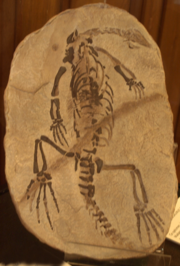
Claudiosaurus
Encyclopedia
Claudiosaurus is an extinct genus
of diapsid
reptile
from the Permian
period of Madagascar.
 Claudiosaurus was one of the first members of the Neodiapsida
Claudiosaurus was one of the first members of the Neodiapsida
, a group of reptiles containing most diapsids except the primitive Araeoscelidia
. It had a relatively long body and neck, reaching on overall length of about 60 centimetres (2 ft). It is presumed to have been partially ocean
ic, living its life in a way similar to the modern Marine Iguana
. The main reason for this theory is that the skeleton included substantial amounts cartilage
, rather than bone
, indicating it had trouble supporting its weight on land. In particular, the sternum
was poorly developed, which would have made walking difficult out of water. Instead, it probably swam by undulating its body and tail, and holding its legs close to the body to increase streamlining.
Genus
In biology, a genus is a low-level taxonomic rank used in the biological classification of living and fossil organisms, which is an example of definition by genus and differentia...
of diapsid
Diapsid
Diapsids are a group of reptiles that developed two holes in each side of their skulls, about 300 million years ago during the late Carboniferous period. Living diapsids are extremely diverse, and include all crocodiles, lizards, snakes, and tuatara...
reptile
Reptile
Reptiles are members of a class of air-breathing, ectothermic vertebrates which are characterized by laying shelled eggs , and having skin covered in scales and/or scutes. They are tetrapods, either having four limbs or being descended from four-limbed ancestors...
from the Permian
Permian
The PermianThe term "Permian" was introduced into geology in 1841 by Sir Sir R. I. Murchison, president of the Geological Society of London, who identified typical strata in extensive Russian explorations undertaken with Edouard de Verneuil; Murchison asserted in 1841 that he named his "Permian...
period of Madagascar.

Neodiapsida
Neodiapsida is a clade or major branch of the reptilian family tree, that includes all Diapsids apart from some early primitive types known as Araeoscelidia....
, a group of reptiles containing most diapsids except the primitive Araeoscelidia
Araeoscelidia
Araeoscelidia or Araeoscelida is a clade of extinct diapsid reptiles superficially resembling lizards, extending from the Late Carboniferous to the Early Permian....
. It had a relatively long body and neck, reaching on overall length of about 60 centimetres (2 ft). It is presumed to have been partially ocean
Ocean
An ocean is a major body of saline water, and a principal component of the hydrosphere. Approximately 71% of the Earth's surface is covered by ocean, a continuous body of water that is customarily divided into several principal oceans and smaller seas.More than half of this area is over 3,000...
ic, living its life in a way similar to the modern Marine Iguana
Marine iguana
The Marine Iguana is an iguana found only on the Galápagos Islands that has the ability, unique among modern lizards, to live and forage in the sea, making it a marine reptile. The Iguana can dive over 30 ft into the water. It has spread to all the islands in the archipelago, and is...
. The main reason for this theory is that the skeleton included substantial amounts cartilage
Cartilage
Cartilage is a flexible connective tissue found in many areas in the bodies of humans and other animals, including the joints between bones, the rib cage, the ear, the nose, the elbow, the knee, the ankle, the bronchial tubes and the intervertebral discs...
, rather than bone
Bone
Bones are rigid organs that constitute part of the endoskeleton of vertebrates. They support, and protect the various organs of the body, produce red and white blood cells and store minerals. Bone tissue is a type of dense connective tissue...
, indicating it had trouble supporting its weight on land. In particular, the sternum
Sternum
The sternum or breastbone is a long flat bony plate shaped like a capital "T" located anteriorly to the heart in the center of the thorax...
was poorly developed, which would have made walking difficult out of water. Instead, it probably swam by undulating its body and tail, and holding its legs close to the body to increase streamlining.

